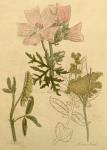A common wild plant, with three leaves at a joint, and long straggling spikes of yellow flowers. It is a foot and a half high, or more. The stalk is weak, slender, green, and striated. The leaves are oblong, and blunt at the ends: they are serrated round the edges, and of a bright green colour. The flowers are small, and of the shape of the flowers of tares, but little; and there follows each a roundish pod, rough and green. The whole plant has a singular, but not disagreeable smell; and the leaves are the food of so many insects, that they are commonly gnawn to pieces.
The fresh plant is excellent to mix in pultices, to be applied to swellings. It was once famous in a plaister, used for dressing of blisters, but the apothecaries used to play so many bad tricks, to imitate the green colour it was expected to give, that the plaister is now made without it.


